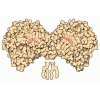[English] 日本語
 Yorodumi
Yorodumi- PDB-6b70: Cryo-EM structure of human insulin degrading enzyme in complex wi... -
+ Open data
Open data
- Basic information
Basic information
| Entry | Database: PDB / ID: 6b70 | |||||||||||||||
|---|---|---|---|---|---|---|---|---|---|---|---|---|---|---|---|---|
| Title | Cryo-EM structure of human insulin degrading enzyme in complex with FAB H11-E heavy chain, FAB H11-E light chain and insulin | |||||||||||||||
 Components Components |
| |||||||||||||||
 Keywords Keywords | HYDROLASE/IMMUNE SYSTEM/HORMONE / IDE / insulin degrading enzyme / amyloid beta / BIOSYNTHETIC PROTEIN / HYDROLASE-IMMUNE SYSTEM-HORMONE complex | |||||||||||||||
| Function / homology |  Function and homology information Function and homology informationinsulysin / ubiquitin recycling / insulin metabolic process / insulin catabolic process / amyloid-beta clearance by cellular catabolic process / hormone catabolic process / bradykinin catabolic process / insulin binding / negative regulation of NAD(P)H oxidase activity / regulation of aerobic respiration ...insulysin / ubiquitin recycling / insulin metabolic process / insulin catabolic process / amyloid-beta clearance by cellular catabolic process / hormone catabolic process / bradykinin catabolic process / insulin binding / negative regulation of NAD(P)H oxidase activity / regulation of aerobic respiration / negative regulation of glycogen catabolic process / positive regulation of nitric oxide mediated signal transduction / peptide catabolic process / negative regulation of fatty acid metabolic process / Signaling by Insulin receptor / negative regulation of feeding behavior / IRS activation / Insulin processing / regulation of protein secretion / positive regulation of peptide hormone secretion / Regulation of gene expression in beta cells / positive regulation of respiratory burst / amyloid-beta clearance / immunoglobulin complex / negative regulation of acute inflammatory response / peroxisomal matrix / alpha-beta T cell activation / regulation of amino acid metabolic process / negative regulation of respiratory burst involved in inflammatory response / positive regulation of dendritic spine maintenance / Synthesis, secretion, and deacylation of Ghrelin / amyloid-beta metabolic process / negative regulation of protein secretion / negative regulation of gluconeogenesis / fatty acid homeostasis / positive regulation of glycogen biosynthetic process / Signal attenuation / FOXO-mediated transcription of oxidative stress, metabolic and neuronal genes / negative regulation of lipid catabolic process / COPI-mediated anterograde transport / regulation of protein localization to plasma membrane / positive regulation of lipid biosynthetic process / positive regulation of insulin receptor signaling pathway / negative regulation of oxidative stress-induced intrinsic apoptotic signaling pathway / positive regulation of protein autophosphorylation / nitric oxide-cGMP-mediated signaling / activation of protein kinase B activity / transport vesicle / negative regulation of reactive oxygen species biosynthetic process / Insulin receptor recycling / insulin-like growth factor receptor binding / positive regulation of brown fat cell differentiation / NPAS4 regulates expression of target genes / positive regulation of protein metabolic process / neuron projection maintenance / endoplasmic reticulum-Golgi intermediate compartment membrane / Insulin receptor signalling cascade / positive regulation of mitotic nuclear division / peptide binding / positive regulation of nitric-oxide synthase activity / proteolysis involved in protein catabolic process / positive regulation of glycolytic process / positive regulation of long-term synaptic potentiation / positive regulation of cytokine production / endosome lumen / acute-phase response / negative regulation of proteolysis / positive regulation of D-glucose import / positive regulation of protein secretion / positive regulation of cell differentiation / Regulation of insulin secretion / Peroxisomal protein import / insulin receptor binding / regulation of transmembrane transporter activity / wound healing / protein catabolic process / negative regulation of protein catabolic process / hormone activity / antigen processing and presentation of endogenous peptide antigen via MHC class I / regulation of synaptic plasticity / metalloendopeptidase activity / positive regulation of neuron projection development / cognition / Golgi lumen / positive regulation of protein localization to nucleus / glucose metabolic process / vasodilation / positive regulation of protein catabolic process / insulin receptor signaling pathway / glucose homeostasis / peroxisome / positive regulation of protein binding / cell-cell signaling / positive regulation of NF-kappaB transcription factor activity / regulation of protein localization / virus receptor activity / PI5P, PP2A and IER3 Regulate PI3K/AKT Signaling / positive regulation of cell growth / protease binding / secretory granule lumen Similarity search - Function | |||||||||||||||
| Biological species |  Homo sapiens (human) Homo sapiens (human) | |||||||||||||||
| Method | ELECTRON MICROSCOPY / single particle reconstruction / cryo EM / Resolution: 3.7 Å | |||||||||||||||
 Authors Authors | Liang, W.G. / Zhang, Z. / Bailey, L.J. / Kossiakoff, A.A. / Tan, Y.Z. / Wei, H. / Carragher, B. / Potter, S.C. / Tang, W.J. | |||||||||||||||
| Funding support |  United States, 4items United States, 4items
| |||||||||||||||
 Citation Citation |  Journal: Elife / Year: 2018 Journal: Elife / Year: 2018Title: Ensemble cryoEM elucidates the mechanism of insulin capture and degradation by human insulin degrading enzyme. Authors: Zhening Zhang / Wenguang G Liang / Lucas J Bailey / Yong Zi Tan / Hui Wei / Andrew Wang / Mara Farcasanu / Virgil A Woods / Lauren A McCord / David Lee / Weifeng Shang / Rebecca Deprez- ...Authors: Zhening Zhang / Wenguang G Liang / Lucas J Bailey / Yong Zi Tan / Hui Wei / Andrew Wang / Mara Farcasanu / Virgil A Woods / Lauren A McCord / David Lee / Weifeng Shang / Rebecca Deprez-Poulain / Benoit Deprez / David R Liu / Akiko Koide / Shohei Koide / Anthony A Kossiakoff / Sheng Li / Bridget Carragher / Clinton S Potter / Wei-Jen Tang /   Abstract: Insulin degrading enzyme (IDE) plays key roles in degrading peptides vital in type two diabetes, Alzheimer's, inflammation, and other human diseases. However, the process through which IDE recognizes ...Insulin degrading enzyme (IDE) plays key roles in degrading peptides vital in type two diabetes, Alzheimer's, inflammation, and other human diseases. However, the process through which IDE recognizes peptides that tend to form amyloid fibrils remained unsolved. We used cryoEM to understand both the apo- and insulin-bound dimeric IDE states, revealing that IDE displays a large opening between the homologous ~55 kDa N- and C-terminal halves to allow selective substrate capture based on size and charge complementarity. We also used cryoEM, X-ray crystallography, SAXS, and HDX-MS to elucidate the molecular basis of how amyloidogenic peptides stabilize the disordered IDE catalytic cleft, thereby inducing selective degradation by substrate-assisted catalysis. Furthermore, our insulin-bound IDE structures explain how IDE processively degrades insulin by stochastically cutting either chain without breaking disulfide bonds. Together, our studies provide a mechanism for how IDE selectively degrades amyloidogenic peptides and offers structural insights for developing IDE-based therapies. | |||||||||||||||
| History |
|
- Structure visualization
Structure visualization
| Movie |
 Movie viewer Movie viewer |
|---|---|
| Structure viewer | Molecule:  Molmil Molmil Jmol/JSmol Jmol/JSmol |
- Downloads & links
Downloads & links
- Download
Download
| PDBx/mmCIF format |  6b70.cif.gz 6b70.cif.gz | 498.4 KB | Display |  PDBx/mmCIF format PDBx/mmCIF format |
|---|---|---|---|---|
| PDB format |  pdb6b70.ent.gz pdb6b70.ent.gz | 398.7 KB | Display |  PDB format PDB format |
| PDBx/mmJSON format |  6b70.json.gz 6b70.json.gz | Tree view |  PDBx/mmJSON format PDBx/mmJSON format | |
| Others |  Other downloads Other downloads |
-Validation report
| Summary document |  6b70_validation.pdf.gz 6b70_validation.pdf.gz | 1.1 MB | Display |  wwPDB validaton report wwPDB validaton report |
|---|---|---|---|---|
| Full document |  6b70_full_validation.pdf.gz 6b70_full_validation.pdf.gz | 1.1 MB | Display | |
| Data in XML |  6b70_validation.xml.gz 6b70_validation.xml.gz | 83.1 KB | Display | |
| Data in CIF |  6b70_validation.cif.gz 6b70_validation.cif.gz | 127.9 KB | Display | |
| Arichive directory |  https://data.pdbj.org/pub/pdb/validation_reports/b7/6b70 https://data.pdbj.org/pub/pdb/validation_reports/b7/6b70 ftp://data.pdbj.org/pub/pdb/validation_reports/b7/6b70 ftp://data.pdbj.org/pub/pdb/validation_reports/b7/6b70 | HTTPS FTP |
-Related structure data
| Related structure data |  7062MC  7041C  7065C  7066C  7090C  7091C  7092C  7093C  5wobC  6b3qC  6b7yC  6b7zC  6bf6C  6bf7C  6bf8C  6bf9C  6bfcC M: map data used to model this data C: citing same article ( |
|---|---|
| Similar structure data |
- Links
Links
- Assembly
Assembly
| Deposited unit | 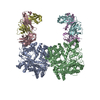
|
|---|---|
| 1 | 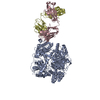
|
- Components
Components
| #1: Protein | Mass: 111866.484 Da / Num. of mol.: 2 / Fragment: residues 46-1011 Source method: isolated from a genetically manipulated source Source: (gene. exp.)  Homo sapiens (human) / Gene: IDE / Production host: Homo sapiens (human) / Gene: IDE / Production host:  #2: Antibody | Mass: 23057.748 Da / Num. of mol.: 2 Source method: isolated from a genetically manipulated source Source: (gene. exp.)   Homo sapiens (human) Homo sapiens (human)Production host:  #3: Antibody | Mass: 23087.609 Da / Num. of mol.: 2 Source method: isolated from a genetically manipulated source Source: (gene. exp.)   Homo sapiens (human) Homo sapiens (human)Production host:  #4: Protein | Mass: 11989.862 Da / Num. of mol.: 2 Source method: isolated from a genetically manipulated source Source: (gene. exp.)  Homo sapiens (human) / Gene: INS / Production host: Homo sapiens (human) / Gene: INS / Production host:  Has protein modification | Y | |
|---|
-Experimental details
-Experiment
| Experiment | Method: ELECTRON MICROSCOPY |
|---|---|
| EM experiment | Aggregation state: PARTICLE / 3D reconstruction method: single particle reconstruction |
- Sample preparation
Sample preparation
| Component | Name: Insulin degrading enzyme/Insulin / Type: COMPLEX Details: Cryo-EM structure of human insulin degrading enzyme in complex with insulin Entity ID: all / Source: RECOMBINANT | ||||||||||||||||||||
|---|---|---|---|---|---|---|---|---|---|---|---|---|---|---|---|---|---|---|---|---|---|
| Molecular weight | Value: 0.1 MDa / Experimental value: YES | ||||||||||||||||||||
| Source (natural) | Organism:  Homo sapiens (human) Homo sapiens (human) | ||||||||||||||||||||
| Source (recombinant) | Organism:  | ||||||||||||||||||||
| Buffer solution | pH: 7.8 | ||||||||||||||||||||
| Buffer component |
| ||||||||||||||||||||
| Specimen | Conc.: 0.3 mg/ml / Embedding applied: NO / Shadowing applied: NO / Staining applied: NO / Vitrification applied: YES / Details: The sample was monodisperse | ||||||||||||||||||||
| Specimen support | Grid material: COPPER / Grid mesh size: 300 divisions/in. / Grid type: Homemade | ||||||||||||||||||||
| Vitrification | Instrument: HOMEMADE PLUNGER / Cryogen name: ETHANE / Humidity: 85 % / Chamber temperature: 298 K Details: The cryo grids were made using Spotiton and homemade plunger |
- Electron microscopy imaging
Electron microscopy imaging
| Experimental equipment |  Model: Titan Krios / Image courtesy: FEI Company |
|---|---|
| Microscopy | Model: FEI TITAN KRIOS |
| Electron gun | Electron source:  FIELD EMISSION GUN / Accelerating voltage: 300 kV / Illumination mode: FLOOD BEAM FIELD EMISSION GUN / Accelerating voltage: 300 kV / Illumination mode: FLOOD BEAM |
| Electron lens | Mode: BRIGHT FIELD / Nominal magnification: 22500 X / Calibrated magnification: 46598 X / Nominal defocus max: 2200 nm / Nominal defocus min: 940 nm / Cs: 2.7 mm / C2 aperture diameter: 70 µm / Alignment procedure: COMA FREE |
| Specimen holder | Cryogen: NITROGEN / Specimen holder model: FEI TITAN KRIOS AUTOGRID HOLDER / Temperature (max): 70 K / Temperature (min): 70 K / Residual tilt: 10 mradians |
| Image recording | Average exposure time: 10 sec. / Electron dose: 71.4 e/Å2 / Detector mode: COUNTING / Film or detector model: GATAN K2 SUMMIT (4k x 4k) / Num. of grids imaged: 3 / Num. of real images: 3085 |
| Image scans | Sampling size: 5 µm / Width: 3710 / Height: 3838 / Movie frames/image: 50 / Used frames/image: 1-50 |
- Processing
Processing
| Software | Name: PHENIX / Version: 1.12_2829: / Classification: refinement | ||||||||||||||||||||||||||||||||||||||||||||
|---|---|---|---|---|---|---|---|---|---|---|---|---|---|---|---|---|---|---|---|---|---|---|---|---|---|---|---|---|---|---|---|---|---|---|---|---|---|---|---|---|---|---|---|---|---|
| EM software |
| ||||||||||||||||||||||||||||||||||||||||||||
| CTF correction | Type: PHASE FLIPPING AND AMPLITUDE CORRECTION | ||||||||||||||||||||||||||||||||||||||||||||
| Particle selection | Num. of particles selected: 762283 | ||||||||||||||||||||||||||||||||||||||||||||
| 3D reconstruction | Resolution: 3.7 Å / Resolution method: FSC 0.143 CUT-OFF / Num. of particles: 116122 / Algorithm: FOURIER SPACE / Num. of class averages: 1 / Symmetry type: POINT | ||||||||||||||||||||||||||||||||||||||||||||
| Atomic model building | B value: 92 / Protocol: FLEXIBLE FIT / Space: REAL | ||||||||||||||||||||||||||||||||||||||||||||
| Refine LS restraints |
|
 Movie
Movie Controller
Controller


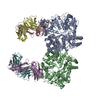
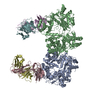

 PDBj
PDBj
















